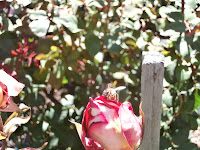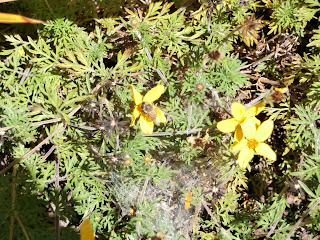First the good news. I went into the old hive. First, in the upper brood box I saw capped honey, larvae and capped brood. In the lower box there was even more capped brood, larvae and even some eggs. Then I spotted the queen! I believe she's new because she looks less dark, more golden, than I recall. She's still a bit smaller than the queens in the other hives. So the old hive looks healthy. There were a few frames of capped honey in the upper brood box. The bees do seem a bit more feisty, but that is something difficult to measure.
Now the bad news. Actually three bits of bad news.
1. I wanted to take a look into Olea's hive. Instead of taking bars from the end, I tried to take a bar from near the end. I got it loose ok, took it out ok, but then I must have tilted it because it broke partway off the bar. I managed to stop it and keep it balanced verically. But when I tried to invert it to put back into the hive, it broke off even moreso. I finally just took it off, deciding to take it in for the honey. I looked carefully to make sure the queen was not on the comb, shook and then brushed off the bees and put the bar back in place with its remnant of comb. There was some capped brood in the broken piece, but what could I do? Then I saw that some of the brood was hatching. So I propped the comb on top of the bars and left it there.
 |
| Spilt honey and broken comb |
 |
| About 1 1/2 hours later |
2. Some bees got mired in the spilt honey. While trying to free one, a drone, I saw a mite on its abdomen. So Olea's hive has mites, and maybe a lot of them. I'll have to do a sugar shake count. I also don't know how to treat a top bar hive for mites. Most top bar beekeepers don't treat at all. Top bar hive, being more natural, have smaller cells that the mites supposedly don't like. I suppose one can but the thymol or formic acid in the hive. I'll ask my mentors.
3. In the old hive, there was capped brood in the drone frame, so I took it out and put an empty one in. All the pupae I tried to examine for mites were upside down in the cells. That is, their abdominal ends were up. At least, that's what it looked like. I went online for an explanation. It seems that the bees may be infected with a virus called sacbrood. There is no treatment. Control involves removing comb that has infected brood, replacing old, dark comb and re-queening. I may ask my mentors to help me determine if I do have sacbrood.
If it's not one thing, it's another.


















